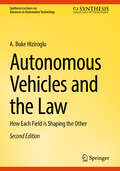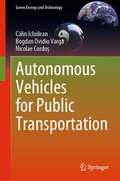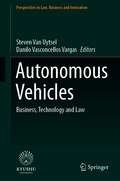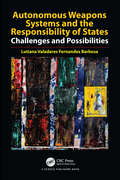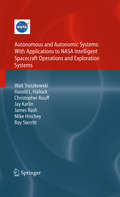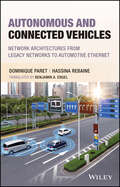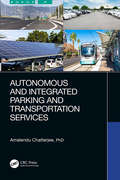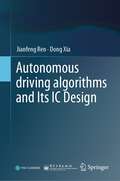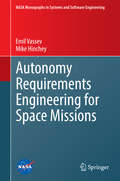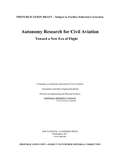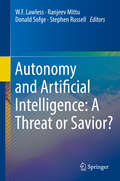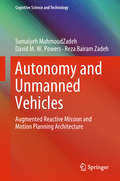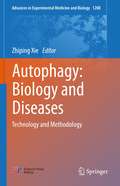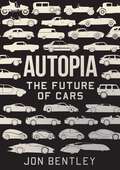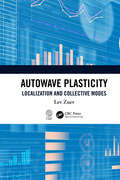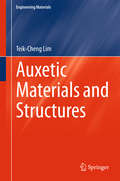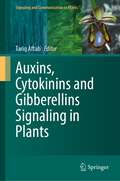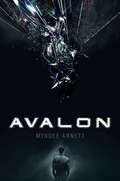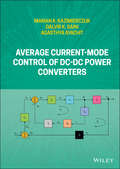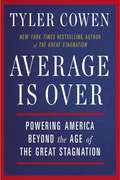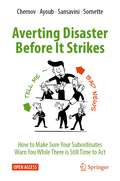- Table View
- List View
Autonomous Vehicles and the Law: How Each Field is Shaping the Other (Synthesis Lectures on Advances in Automotive Technology)
by A. Buke HizirogluDisciplines can no longer be isolated. Technology has rapidly evolved to the point that driverless vehicles have truly become a reality and are not something out of a futuristic exhibition from the 1950s. However, engineers and researchers working on the development of autonomous vehicles cannot ignore the policy implications and policymakers as well as attorneys cannot ignore the technology. We are at a point where cross-disciplinary collaboration is vital in order to produce a technology that will immensely benefit society. This is the goal of this book: to educate autonomous vehicle developers on legal theory at the most basic level. Both policymakers and lawyers may also find the book helpful in gaining a basic understanding of the technology the developers are working on. The 2nd edition will dive further into cyber security as well as provide legal hypotheticals to give a perspective to engineers or others working in the field. Additionally, it will focus more on liability,which has had some changes recently.
Autonomous Vehicles for Public Transportation (Green Energy and Technology)
by Bogdan Ovidiu Varga Călin Iclodean Nicolae CordoșThis book presents an interdisciplinary approach to autonomous driving technology design and development. It discusses a methodology of simulation that allows specialists to evaluate autonomous vehicle sensors functionality and integration, energy flow, efficiency, range, and service under public transport.The design, calibration, and physical model behind each autonomous vehicle sensor and component is explained. For each specific vehicle, the powertrain is analyzed, and output results are presented through the use of specific automotive industrial software (IPG CarMaker).The book gives the reader a clear perspective of the key factors influencing the global functionality of autonomous shuttle buses with respect to both their inner components the variable exterior factors and an exhaustive legal perspective in relation of their presence on public roads.
Autonomous Vehicles: Business, Technology and Law (Perspectives in Law, Business and Innovation)
by Steven Van Uytsel Danilo Vasconcellos VargasThis edited book aims to address challenges facing the deployment of autonomous vehicles. Autonomous vehicles were predicted to hit the road by 2017. Even though a high degree of automation may have been achieved, vehicles that can drive autonomously under all circumstances are not yet commercially available, and the predictions have been adjusted. Now, experts even say that we are still decades away from fully autonomous vehicles. In this volume, the authors form a multidisciplinary team of experts to discuss some of the reasons behind this delay. The focus is on three areas: business, technology, and law. The authors discuss how the traditional car manufacturers have to devote numerous resources to the development of a new business model, in which the sole manufacturing of vehicles may no longer be sufficient. In addition, the book seeks to introduce how technological challenges are creating a shift toward connected autonomous vehicles. Further, it provides insight into how regulators are responding to the insufficiently tested technology and how lawyers try to answer the liability question for accidents with these autonomous vehicles.
Autonomous Weapons Systems
by Liu Claus Kreß Susanne Beck Robin Geiß Nehal Bhuta Hin-YanThe intense and polemical debate over the legality and morality of weapons systems to which human cognitive functions are delegated (up to and including the capacity to select targets and release weapons without further human intervention) addresses a phenomena which does not yet exist but which is widely claimed to be emergent. This groundbreaking collection combines contributions from roboticists, legal scholars, philosophers and sociologists of science in order to recast the debate in a manner that clarifies key areas and articulates questions for future research. The contributors develop insights with direct policy relevance, including who bears responsibility for autonomous weapons systems, whether they would violate fundamental ethical and legal norms, and how to regulate their development. It is essential reading for those concerned about this emerging phenomenon and its consequences for the future of humanity.
Autonomous Weapons Systems and the Responsibility of States: Challenges and Possibilities
by Lutiana Valadares Fernandes BarbosaThis book reviews whether the existing framework in place can effectively address breaches in the context of Autonomous Weapons Systems (AWS). The work endeavors to map out the main gaps and some possible approaches to address them. Part I sets the ground. First, it provides a concept of AWS. Next, it discusses the accountability gap AWS generate and shows how the international community has put far more emphasis on individual responsibility rather than state responsibility. Part II analyzes the challenges AWS pose to the regime governing state responsibility under international law, as codified in the Draft Articles on State Responsibility (ARSIWA). In this regard, it discusses attribution, breach of an international obligation, tempus comissi delicti, multiple states involved in a breach, force majeure, assurance of non-repetition, issues related to damage, the human-machine interaction and its impacts on state´s responsibility, responsibility for not using AWS, weapons review and the duty of due diligence. Part III summarizes the challenges discussed in part II in thirteen issues of concern and presents possible paths de lege ferenda to address each of those issues, mainly a paradigm shift in attribution and strict liability, among seven other more specific proposals. The conclusion reached is that the current regime on the international responsibility of states is insufficient to deal with the new challenges AWS pose. De lege ferenda, the book argues for following the paths suggested in part III. It also reflects on parts II and III's findings and how many of AWS's challenges to state´s responsibility apply to other autonomous devices. Therefore, through the case study of AWS, this work also opens the broader discussion of the gaps in the international responsibility of states regarding autonomous device misdoings.
Autonomous and Autonomic Systems: With Applications To Nasa Intelligent Spacecraft Operations And Exploration Systems (NASA Monographs in Systems and Software Engineering)
by Christopher Rouff Michael Hinchey Walt Truszkowski James Rash Jay Karlin Roy Sterritt Harold HallockThis book provides an in-depth discussion of autonomous and autonomic systems, their interdependencies, differences and similarities. Current and pending issues in these evermore increasingly important subjects are highlighted and discussed. Concepts, ideas and experiences are explored in relation to real-life NASA systems in spacecraft control and in the exploration domain.
Autonomous and Connected Vehicles: Network Architectures from Legacy Networks to Automotive Ethernet
by Dominique Paret Hassina RebaineAUTONOMOUS AND CONNECTED VEHICLES Discover the latest developments in autonomous vehicles and what the future holds for this exciting technology In Autonomous and Connected Vehicles, networking experts Dominique Paret and Hassina Rebaine deliver a robust exploration of the major technological changes taking place in the field, and describe the different levels of autonomy possible with current technologies and the legal and regulatory contexts in which new autonomous vehicles will circulate. The book also includes discussions of the sensors, including infrared, ultrasound, cameras, lidar, and radar, used by modern autonomous vehicles. Readers will enjoy the intuitive descriptions of Advanced Driver Assistance Systems (ADAS), network architectures (CAN-FD, FlexRay, and Backbone Ethernet), and software that power current and future autonomous vehicles. The authors also discuss how ADAS can be fused with data flowing over newer and faster network architectures and artificial intelligence to create greater levels of autonomy. The book also includes: A thorough introduction to the buzz and hype surrounding autonomous and connected vehicles, including a brief history of the autonomous vehicle Comprehensive explorations of common issues affecting autonomous and connected vehicles, including regulatory guidelines, legislation, relevant norms and standards, and insurance issues Practical discussions of autonomous vehicle sensors, from DAS to ADAS and HADAS, and VA L3 to L5 In-depth examinations of networks and architecture, including discussions of data fusion, artificial intelligence, and hardware architecture in vehicles Perfect for graduate and undergraduate students in programs dealing with the intersection of wireless communication technologies and vehicles, Autonomous and Connected Vehicles is also a must-read reference for industry professionals and researchers seeking a one-stop reference for the latest developments in vehicle communications technology.
Autonomous and Integrated Parking and Transportation Services
by Amalendu ChatterjeeIn this book, the author outlines a Robust Web Parking, Truck and Transportation Portal (RWPTTP) for integrating parking and transportation services – a revolutionary approach in contrast to incremental change for managing traffic congestion. Autonomous vehicle technology, artificial intelligence, internet of things (IOT), and other interconnected hardware and software tools will assist autonomous parking and transportation services and provide next-century infrastructure for consolidated transportation customer services. The book highlights currently available autonomous parking and transportation technologies, and the development of an integrated and intelligent transportation service/system (IITS) platform, with specific use of technologies to reconfigure the transportation industry. The author also suggests many regulatory and policy changes to simplify data collection, traffic operation, introduction of a duplicate transportation system using light rail (LRs) and high speed rail (SPRs), and redistribution of parking spaces along such routes, using renewable energy.
Autonomous driving algorithms and Its IC Design
by Jianfeng Ren Dong XiaWith the rapid development of artificial intelligence and the emergence of various new sensors, autonomous driving has grown in popularity in recent years. The implementation of autonomous driving requires new sources of sensory data, such as cameras, radars, and lidars, and the algorithm processing requires a high degree of parallel computing. In this regard, traditional CPUs have insufficient computing power, while DSPs are good at image processing but lack sufficient performance for deep learning. Although GPUs are good at training, they are too “power-hungry,” which can affect vehicle performance. Therefore, this book looks to the future, arguing that custom ASICs are bound to become mainstream. With the goal of ICs design for autonomous driving, this book discusses the theory and engineering practice of designing future-oriented autonomous driving SoC chips.The content is divided into thirteen chapters, the first chapter mainly introduces readers to the current challenges and research directions in autonomous driving. Chapters 2–6 focus on algorithm design for perception and planning control. Chapters 7–10 address the optimization of deep learning models and the design of deep learning chips, while Chapters 11-12 cover automatic driving software architecture design. Chapter 13 discusses the 5G application on autonomous drving. This book is suitable for all undergraduates, graduate students, and engineering technicians who are interested in autonomous driving.
Autonomy Requirements Engineering for Space Missions (NASA Monographs in Systems and Software Engineering)
by Mike Hinchey Emil VassevAdvanced space exploration is performed by unmanned missions with integrated autonomy in both flight and ground systems. Risk and feasibility are major factors supporting the use of unmanned craft and the use of automation and robotic technologies where possible. Autonomy in space helps to increase the amount of science data returned from missions, perform new science, and reduce mission costs. Elicitation and expression of autonomy requirements is one of the most significant challenges the autonomous spacecraft engineers need to overcome today. This book discusses the Autonomy Requirements Engineering (ARE) approach, intended to help software engineers properly elicit, express, verify, and validate autonomy requirements. Moreover, a comprehensive state-of-the-art of software engineering for aerospace is presented to outline the problems handled by ARE along with a proof-of-concept case study on the ESA's BepiColombo Mission demonstrating the ARE's ability to handle autonomy requirements.
Autonomy Research for Civil Aviation: Toward a New Era of Flight
by Committee on Autonomy Research for Civil AviationThe development and application of increasingly autonomous (IA) systems for civil aviation is proceeding at an accelerating pace, driven by the expectation that such systems will return significant benefits in terms of safety, reliability, efficiency, affordability, and/or previously unattainable mission capabilities. IA systems range from current automatic systems such as autopilots and remotely piloted unmanned aircraft to more highly sophisticated systems that are needed to enable a fully autonomous aircraft that does not require a pilot or human air traffic controllers. These systems, characterized by their ability to perform more complex mission-related tasks with substantially less human intervention for more extended periods of time, sometimes at remote distances, are being envisioned for aircraft and for air traffic management and other ground-based elements of the national airspace system. Civil aviation is on the threshold of potentially revolutionary improvements in aviation capabilities and operations associated with IA systems. These systems, however, face substantial barriers to integration into the national airspace system without degrading its safety or efficiency. "Autonomy Research for Civil Aviation" identifies key barriers and suggests major elements of a national research agenda to address those barriers and help realize the benefits that IA systems can make to crewed aircraft, unmanned aircraft systems, and ground-based elements of the national airspace system. This report develops a set of integrated and comprehensive technical goals and objectives of importance to the civil aeronautics community and the nation. "Autonomy Research for Civil Aviation" will be of interest to U. S. research organizations, industry, and academia who have a role in meeting these goals.
Autonomy and Artificial Intelligence: A Threat or Savior?
by Stephen Russell Ranjeev Mittu Donald Sofge W. F. LawlessThis book explores how Artificial Intelligence (AI), by leading to an increase in the autonomy of machines and robots, is offering opportunities for an expanded but uncertain impact on society by humans, machines, and robots. To help readers better understand the relationships between AI, autonomy, humans and machines that will help society reduce human errors in the use of advanced technologies (e.g., airplanes, trains, cars), this edited volume presents a wide selection of the underlying theories, computational models, experimental methods, and field applications. While other literature deals with these topics individually, this book unifies the fields of autonomy and AI, framing them in the broader context of effective integration for human-autonomous machine and robotic systems. The contributions, written by world-class researchers and scientists, elaborate on key research topics at the heart of effective human-machine-robot-systems integration. These topics include, for example, computational support for intelligence analyses; the challenge of verifying today’s and future autonomous systems; comparisons between today’s machines and autism; implications of human information interaction on artificial intelligence and errors; systems that reason; the autonomy of machines, robots, buildings; and hybrid teams, where hybrid reflects arbitrary combinations of humans, machines and robots. The contributors span the field of autonomous systems research, ranging from industry and academia to government. Given the broad diversity of the research in this book, the editors strove to thoroughly examine the challenges and trends of systems that implement and exhibit AI; the social implications of present and future systems made autonomous with AI; systems with AI seeking to develop trusted relationships among humans, machines, and robots; and the effective human systems integration that must result for trust in these new systems and their applications to increase and to be sustained.
Autonomy and Unmanned Vehicles: Augmented Reactive Mission And Motion Planning Architecture (Cognitive Science And Technology Ser.)
by Somaiyeh MahmoudZadeh Reza Bairam Zadeh David M.W. PowersThis book addresses higher–lower level decision autonomy for autonomous vehicles, and discusses the addition of a novel architecture to cover both levels. The proposed framework’s performance and stability are subsequently investigated by employing different meta-heuristic algorithms. The performance of the proposed architecture is shown to be largely independent of the algorithms employed; the use of diverse algorithms (subjected to the real-time performance of the algorithm) does not negatively affect the system’s real-time performance. By analyzing the simulation results, the book demonstrates that the proposed model provides perfect mission timing and task management, while also guaranteeing secure deployment. Although mainly intended as a research work, the book’s review chapters and the new approaches developed here are also suitable for use in courses for advanced undergraduate or graduate students.
Autophagy: Technology and Methodology (Advances in Experimental Medicine and Biology #1208)
by Zhiping XieThis book series consists of 3 volumes covering the basic science (Volume 1), clinical science (Volume 2) and the technology and methodology (Volume 3) of autophagy. Volume 3 focuses on the technical aspects of autophagy research. It is comprised of two parts. The first part discusses the basic process of autophagy, including its overall classification and individual stages in the life cycle of autophagosomes. The second part discusses the tools, strategies, and model systems in current autophagy research, including cell and animal models, detection and manipulation methods, as well as screening, genomic, proteomic and bioinformatic approaches. The book is written and edited by a team of active scientists. It is intended as a practical reference resource for interested researchers to get started on autophagy studies.
Autopia: The Future of Cars
by Jon BentleyCars are one of the most significant human creations. They changed our cities. They changed our lives. They changed everything. But in the next thirty years, this technology will itself change enormously. If Google get their way, are we all going to be ferried around in tiny electric bubble-cars? Or will we watch robots race a bionic Lewis Hamilton? And what about the future of classic cars?In Autopia, presenter of The Gadget Show and former executive producer of Top Gear Jon Bentley celebrates motoring's rich heritage and meets the engineers (and coders) who are transforming cars forever. From mobile hotel rooms to electric battery technology; from hydrogen-powered cars to jetpacks, Autopia is the essential guide to the future of our greatest invention. Fully designed with illustrations and photographs, this will be the perfect Christmas gift for car and technology enthusiasts everywhere.
Autoremprendedor: Cómo Generar Ingresos Estables De Regalías De Libros Electrónicos
by Kristen James Paula Arturo¿Qué es un Autoremprendedor? Viene del inglés "Authorpreneur", un término reciente de los últimos años que se utiliza para encapsular al autor (del inglés, "author") y al empresario emprendedor (del inglés, "entrepeneur"); y que abarca conceptos como el de autores auto-publicados, autores independientes y autores mixtos. Se podría decir que los autores que publican de modo tradicional también son emprendedores. En años anteriores, todas las demás industrias tenían en estima a las personas que emprendían sus propios negocios, pero no fue así en la publicación... al menos, no hasta ahora. La auto-publicación se está convirtiendo en la norma, los autores independientes están alcanzando ingresos estables y los libros auto-publicados están consiguiendo los puestos n.° 1 en las listas de libros electrónicos vendidos. En la última semana de abril de 2013, cinco de los diez mejores libros electrónicos habían sido auto-publicados. La semana anterior a esa, los libros electrónicos n.° 1 y n.° 2 también habían sido auto-publicados. Algunos autores independientes altamente exitosos están firmando acuerdos de solo impresión con las principales editoriales, mientras que otros optan por seguir siendo auto-publicados y conservar todos sus derechos. También hay autores mixtos que utilizan lo mejor de los dos métodos de publicación para alcanzar sus metas y llegar a más lectores. En la actualidad, tenemos opciones. Los que mandan son los lectores. Es un momento increíble para ser autor y me siento muy afortunada de formar parte de estos cambios. Al igual que la edición tradicional, la auto-publicación tiene sus mega-bestsellers, grandes vendedores, autores de mitad de lista y muchos autores con la esperanza de unirse a esas filas. A diferencia de la edición tradicional, la auto-publicación les proporciona la oportunidad a los autores de mitad de lista de ganar un ingreso significativo por su trabajo, incluso en los
Autotrophic Nitrogen Removal from Low Concentrated Effluents: Study of System Configurations and Operational Features for Post-treatment of Anaerobic Effluents (IHE Delft PhD Thesis Series)
by Javier Adrián Sánchez GuillénOn a global scale, sewage represents the main point-source of water pollution and is also the predominant source of nitrogen contamination in urban regions. The present research is focused on the study of the main challenges that need to be addressed in order to achieve a successful inorganic nitrogen post-treatment of anaerobic effluents in the mainstream. The post-treatment is based on autotrophic nitrogen removal. The challenges are classified in terms of operational features and system configuration, namely: (i) the short-term effects of organic carbon source, the COD/N ratio and the temperature on the autotrophic nitrogen removal; the results from this study confirms that the Anammox activity is strongly influenced by temperature, in spite of the COD source and COD/N ratios applied. (ii) The long-term performance of the Anammox process under low nitrogen sludge loading rate (NSLR) and moderate to low temperatures; it demonstrates that NSLR affects nitrogen removal efficiency, granular size and biomass concentration of the bioreactor. (iii) The Anammox cultivation in a closed sponge-bed trickling filter (CSTF) and (iv) the autotrophic nitrogen removal over nitrite in a sponge-bed trickling filter (STF). Both types of Anammox sponge-bed trickling filters offer a plane technology with good nitrogen removal efficiency.
Autowave Plasticity: Localization and Collective Modes
by Lev ZuevAutowave Plasticity: Localization and Collective Modes discusses the nature of plastic flow in solids associated with the development of a localized plastic flow. Written by an authority in the field, the author demonstrates how patterns of localized plastic flow are associated with autowave modes that are generated in a deformable sample and delivers a complete work on the subject. Key Features An original work on the nature of plastic flows in solids, particularly metals and crystals Focuses on plastic flow as an autowave process Contains elements of theories, experimental considerations, and numerical modeling This reference will help readers with creating experimental methods to observe or localize plastic flow and with the modeling of plastic flows. It is a valuable reference for graduate students and research specialists working in material science.
Auxetic Materials and Structures (Engineering Materials)
by Teik-Cheng LimThis book lays down the foundation on the mechanics and design of auxetic solids and structures, solids that possess negative Poisson's ratio. It will benefit two groups of readers: (a) industry practitioners, such as product and structural designers, who need to control mechanical stress distributions using auxetic materials, and (b) academic researchers and students who intend to produce unique mechanical and other physical properties of structures using auxetic materials.
Auxins, Cytokinins and Gibberellins Signaling in Plants (Signaling and Communication in Plants)
by Tariq AftabPlant hormones have pivotal roles in the regulation of plant growth, development, and reproduction. Their signaling pathways are interconnected in a complex network, which provides plants with an enormous regulatory potential to rapidly adapt to their environment and to utilize their limited resources for growth and survival in a cost-efficient manner. Auxin is a hormone molecule whose activity levels are most important for its regulatory roles during plant cell, organ, and tissue development. Therefore, the precise regulation of auxin levels is an essential mechanism to fine-tune the activity of this powerful hormone during plant growth and development. Likewise, cytokinins exhibit a wide range of physiological functions, including regulation of shoot and root apical meristems, stimulation of branching, vascular development, chloroplast differentiation, stabilization of the structure and function of the photosynthetic machinery, delay of senescence, stomata opening, and elevation of the sink strength and nutritional signaling. Moreover, gibberellins also regulate many aspects of plant growth and development including seed germination, stem elongation, leaf expansion, and flower and fruit development. The broad implication of gibberellins in plant development is strictly associated with tight regulation of their metabolism by multiple environmental and endogenous factors, ranging from light and temperature to other hormones including feedback control. Understanding the significant roles of these phytohormones in plant biology, the current subject has attracted the attention of scientists from across the globe. This comprehensive volume “Auxins, Cytokinins and Gibberellins Signaling in Plants” highlights the various prospects involved in the current scenario. The book comprises the chapters from diverse areas dealing with biotechnology, molecular biology, proteomics, genomics, metabolomics, etc.
Avalon
by Mindee ArnettFor fans of Josh Whedon's cult classic television show Firefly comes a fascinating and fast-paced sci-fi thriller from author Mindee Arnett, about a group of teenage mercenaries who stumble upon a conspiracy that threatens the entire galaxy.Jeth Seagrave and his crew have made their name stealing metatech: the devices that allow people to travel great distances faster than the speed of light. In a world where the agencies that patrol the outer edges of space are as corrupt as the crime bosses who control them, it's as much of a living as anyone can ask for. For years Jeth's managed to fly under the radar of the government that executed his parents for treason--but when he finds himself in possession of information that both government and the crime bosses are willing to kill for, he's going to find there's no escaping his past anymore.With pulse-pounding action, a captivating mystery, and even a bit of romance, Avalon is the perfect read for hard-core sci-fi fans and non-sci-fi fans alike.
Avatars of the Word: From Papyrus to Cyberspace
by James J. O'DonnellConsiders the future of the printed word given the growth of electronic communication as a modern medium for information and culture. In investigating past cultural transitions, such as from the spoken to the written word, or from manuscript to the printing press, O'Donnell (classical studies, U. of Pennsylvania) reveals the contemporary crossroads between media as contiguous with the history of communication. Annotation c. by Book News, Inc. , Portland, Or.
Average Current-Mode Control of DC-DC Power Converters
by Marian K. Kazimierczuk Agasthya Ayachit Dalvir K. SainiAVERAGE CURRENT-MODE CONTROL OF DC-DC POWER CONVERTERS An authoritative one-stop guide to the analysis, design, development, and control of a variety of power converter systems Average Current-Mode Control of DC-DC Power Converters provides comprehensive and up-to-date information about average current-mode control (ACMC) of pulse-width modulated (PWM) dc-dc converters. This invaluable one-stop resource covers both fundamental and state-of-the-art techniques in average current-mode control of power electronic converters???featuring novel small-signal models of non-isolated and isolated converter topologies with joint and disjoint switching elements and coverage of frequency and time domain analysis of controlled circuits. The authors employ a systematic theoretical framework supported by step-by-step derivations, design procedures for measuring transfer functions, challenging end-of-chapter problems, easy-to-follow diagrams and illustrations, numerous examples for different power supply specifications, and practical tips for developing power-stage small-signal models using circuit-averaging techniques. The text addresses all essential aspects of modeling, design, analysis, and simulation of average current-mode control of power converter topologies, such as buck, boost, buck-boost, and flyback converters in operating continuous-conduction mode (CCM). Bridging the gap between fundamental modeling methods and their application in a variety of switched-mode power supplies, this book: Discusses the development of small-signal models and transfer functions related to the inner current and outer voltage loops Analyzes inner current loops with average current-mode control and describes their dynamic characteristics Presents dynamic properties of the poles and zeros, time-domain responses of the control circuits, and comparison of relevant modeling techniques Contains a detailed chapter on the analysis and design of control circuits in time-domain and frequency-domain Provides techniques required to produce professional MATLAB plots and schematics for circuit simulations, including example MATLAB codes for the complete design of PWM buck, boost, buck-boost, and flyback DC-DC converters Includes appendices with design equations for steady-state operation in CCM for power converters, parameters of commonly used power MOSFETs and diodes, SPICE models of selected MOSFETs and diodes, simulation tools including introductions to SPICE, MATLAB, and SABER, and MATLAB codes for transfer functions and transient responses Average Current-Mode Control of DC-DC Power Converters is a must-have reference and guide for researchers, advanced graduate students, and instructors in the area of power electronics, and for practicing engineers and scientists specializing in advanced circuit modeling methods for various converters at different operating conditions.
Average Is Over
by Tyler CowenWidely acclaimed as one of the world’s most influential economists, Tyler Cowen returns with his groundbreaking follow-up to the New York Times bestseller The Great Stagnation. The widening gap between rich and poor means dealing with one big, uncomfortable truth: If you’re not at the top, you’re at the bottom. The global labor market is changing radically thanks to growth at the high end-and the low. About three quarters of the jobs created in the United States since the great recession pay only a bit more than minimum wage. Still, the United States has more millionaires and billionaires than any country ever, and we continue to mint them. In this eye-opening book, renowned economist and bestselling author Tyler Cowen explains that phenomenon: High earners are taking ever more advantage of machine intelligence in data analysis and achieving ever-better results. Meanwhile, low earners who haven’t committed to learning, to making the most of new technologies, have poor prospects. Nearly every business sector relies less and less on manual labor, and this fact is forever changing the world of work and wages. A steady, secure life somewhere in the middle-average-is over. With The Great Stagnation, Cowen explained why median wages stagnated over the last four decades; in Average Is Over he reveals the essential nature of the new economy, identifies the best path forward for workers and entrepreneurs, and provides readers with actionable advice to make the most of the new economic landscape. It is a challenging and sober must-read but ultimately exciting, good news. In debates about our nation’s economic future, it will be impossible to ignore. .
Averting Disaster Before It Strikes: How to Make Sure Your Subordinates Warn You While There is Still Time to Act
by Didier Sornette Dmitry Chernov Ali Ayoub Giovanni SansaviniSome of the major industrial disasters could have been prevented. When the facts of what happened are established, their stories share a common thread: before things spiralled out of control, there were workers at the affected sites who knew that the situation was dangerous, and could become catastrophic unless immediate action was taken. But tragically, nobody dared to tell the decision-makers who could have authorized that action. With no idea of the risks they were taking, the people in charge continued as normal… and disaster struck. Because vital information about risks could not flow freely from the shop floor to the director’s office, the crucial decisions were not made in time. This observation has been documented in the following major technological accidents: Challenger space shuttle explosion (USA, 1986); Chernobyl nuclear plant disaster (USSR, 1986); Deepwater Horizon oil spill (USA, 2010); Fukushima-1 nuclear power plant disaster (Japan, 2011); and numerous other industrial disasters. After accidents like these, losses and costs for dealing with the consequences are often hundreds — or even thousands — of times greater than the finances that would have been required to deal with the risks when they were first recognized.This handbook is about how to transform the way large critical infrastructure companies communicate about safety and technological risks. It aims to support senior managers to get the information they need from their subordinates concerning the risks they are facing, in order to prevent accidents before it is too late.The recommendations in this handbook are based on interviews with 100 executives at various levels, working in 65 critical infrastructure companies around the world, in power, oil and gas, metals, chemicals and petrochemicals, mining and other industries.The recommendations of these leaders were also tested in the pilot project, in an industrial company which is the world leader in its sector. More than 400 managers at various levels of the corporate hierarchy, and employees at several of the company’s industrial plants, took part in the project.This open access handbook is written for the owners, senior managers, and industrial safety directors of critical infrastructure companies.
